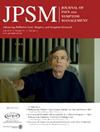Medicare Advantage Contributes to Racial Disparities in Home Health Use Near End-of-life
IF 3.2
2区 医学
Q2 CLINICAL NEUROLOGY
引用次数: 0
Outcomes
1. Participants will be able to understand the basic differences between Traditional Medicare and Medicare Advantage.
2. Participants will be able to describe how MA enrollment impacts home health utilization across racial groups
Key Message
Medicare Advantage (MA) enrollment is growing among Black and Hispanic populations however little is known about how MA enrollment impacts HH utilization across racial groups. This study shows that MA creates new disparities in HH utilization with Hispanic older adults disproportionately impacted. Future research must explain the mechanisms of the unexplained differences in HH utilization at the end of life.
Abstract
Medicare Advantage (MA) enrollment is growing, particularly among Black and Hispanic populations(1). While racial and ethnic disparities in Home Health (HH) access and outcomes have been documented (2,3), little is known about the impact of MA enrollment on HH utilization across racial groups. This is particularly important given the integral role that HH plays in the care of older adults in the last year of life (4).
Objective
To assess the differences in end-of-life HH use and length of stay in TM versus MA across racial and ethnic groups.
Methods
Using a 100% Medicare cohort of 2,153,793 2019 decedents (785,585 in MA), we fit a linear probability model predicting HH use and, among HH users, HH length of stay in the last year of life. We measured the average number of days in HH per 100 eligible days (i.e., at home, not in hospice) in the last year of life. We then compared HH use by racial groups in TM vs. MA. All models included county-level fixed-effects and adjusted for individual characteristics and neighborhood-level deprivation.
Results
In the last year of life, the use of HH was substantially lower in MA vs. TM for Hispanic decedents (32.8 vs. 41.6%, P < 0.001), as well as Asian/Pacific Islander decedents (31.4 vs. 39.9%, p < 0.001). Among HH users, Hispanic decedents received 30.2 fewer days (p < 0.001), Black decedents 19.9 fewer days (p < 0.001) and Asian/Pacific Islanders 16.2 fewer days (p < 0.05) of HH in MA vs. TM at the EOL. Differences of this magnitude were not seen across other racial/ ethnic groups.
Conclusion
Enrollment in MA appears to be widening racial and ethnic disparities in HH utilization at the EOL, particularly for Hispanic older adults. Future research must strive to understand the causes and consequences of these disparities in HH utilization in the MA program.
References
(1) Meyers, D. J., Mor, V., Rahman, M., & Trivedi, A. N. (2021). Growth In Medicare Advantage Greatest Among Black And Hispanic Enrollees: Study examines the extent to which growth in Medicare Advantage is being driven by increased participation of racial/ethnic minorities and other traditionally marginalized groups. Health Affairs, 40(6), 945-950. (2) Jones, T., Luth, E. A., Cleland, C. M., & Brody, A. A. (2024). Race and Ethnicity Are Related to Undesirable Home Health Care Outcomes in Seriously Ill Older Adults. Journal of the American Medical Directors Association, 25(6), 104983. (3) FASHAW‐WALTERS, S. A., Rahman, M., Gee, G., et al. (2023). Potentially more out of reach: public reporting exacerbates inequities in home health access. The Milbank Quarterly, 101(2), 527-559. (4) Bylander J. Community-Focused Health Care For The Seriously Ill. Health Aff Proj Hope. 2019;38(3):344-346. doi:10.1377/hlthaff.2019.00111
医疗保险优势导致生命末期家庭健康使用的种族差异
Outcomes1。参与者将能够理解传统医疗保险和优惠医疗保险的基本区别。参与者将能够描述MA注册如何影响跨种族群体的家庭健康利用。关键信息医疗保险优势(MA)注册在黑人和西班牙裔人群中不断增长,但对于MA注册如何影响跨种族群体的医疗保健利用知之甚少。这项研究表明,MA在西班牙裔老年人的HH利用方面产生了新的差异。未来的研究必须解释生命结束时HH利用的未解释差异的机制。摘要医疗保险优势(MA)的注册人数正在增长,特别是在黑人和西班牙裔人群中(1)。虽然在家庭健康(HH)获取和结果方面的种族和民族差异已被记录(2,3),但关于MA注册对不同种族群体HH利用的影响知之甚少。考虑到HH在老年人生命最后一年的护理中所起的不可或缺的作用,这一点尤为重要(4)。目的评估不同种族和民族群体在临终HH使用和TM与MA住院时间的差异。方法使用100%的医疗保险队列,包括2,153,793名2019年的死者(785,585名MA),我们拟合了一个线性概率模型,预测HH使用情况,以及HH用户在生命最后一年的HH住院时间。我们测量了在生命的最后一年,每100个符合条件的日子(即,在家里,而不是在临终关怀)在HH的平均天数。然后,我们比较了TM和MA中不同种族的HH使用情况。所有模型都包括县级固定效应,并根据个体特征和社区水平的剥夺进行了调整。结果在生命的最后一年,西班牙裔死者中MA与TM的HH使用率明显低于前者(32.8% vs 41.6%, P <;0.001),以及亚洲/太平洋岛民的遗属(31.4比39.9%,p <;0.001)。在HH使用者中,西班牙裔死者少接受30.2天(p <;0.001),黑人后裔少19.9天(p <;0.001),亚洲/太平洋岛民少16.2天(p <;在EOL中,MA与TM的HH差异为0.05)。在其他种族/民族群体中没有看到这种巨大的差异。结论MA的入组似乎扩大了EOL中HH利用的种族和民族差异,特别是西班牙裔老年人。未来的研究必须努力了解这些差异的原因和后果在硕士项目HH利用。参考文献(1)Meyers, D. J, more, V., Rahman, M., &;Trivedi, A. N.(2021)。医疗保险优势的增长在黑人和西班牙裔参保者中最大:研究调查了医疗保险优势的增长在多大程度上是由种族/少数民族和其他传统边缘化群体的参与推动的。卫生事务,40(6),945-950。(2)琼斯,T。,Luth, e·A。克莱兰德,c . M。,布罗迪,a.a.(2024)。种族和民族与危重老年人不良家庭保健结果有关。美国医学主任协会杂志,25(6),104983。(3)李建平,李建平,李建平,等。(2013)。可能更遥不可及:公开报告加剧了家庭保健服务的不平等。《社会科学研究》,2011(2),527-559。(4)刘志强,刘志强。社区卫生服务在重症患者中的应用。中华卫生杂志,2019;38(3):344-346。doi: 10.1377 / hlthaff.2019.00111
本文章由计算机程序翻译,如有差异,请以英文原文为准。
求助全文
约1分钟内获得全文
求助全文
来源期刊
CiteScore
8.90
自引率
6.40%
发文量
821
审稿时长
26 days
期刊介绍:
The Journal of Pain and Symptom Management is an internationally respected, peer-reviewed journal and serves an interdisciplinary audience of professionals by providing a forum for the publication of the latest clinical research and best practices related to the relief of illness burden among patients afflicted with serious or life-threatening illness.

 求助内容:
求助内容: 应助结果提醒方式:
应助结果提醒方式:


